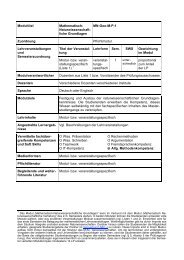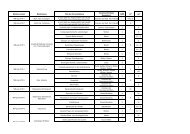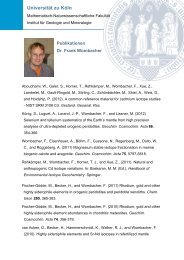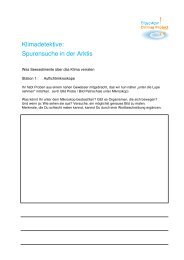Status report on sample preparation facilities for 14C analysis at the ...
Status report on sample preparation facilities for 14C analysis at the ...
Status report on sample preparation facilities for 14C analysis at the ...
Create successful ePaper yourself
Turn your PDF publications into a flip-book with our unique Google optimized e-Paper software.
4 J. Re<strong>the</strong>meyer et al. / Nuclear Instruments and Methods in Physics Research B xxx (2012) xxx–xxx<br />
Table 2<br />
Results <strong>for</strong> reference m<strong>at</strong>erials (ca. 1 mg C) graphitized with <strong>the</strong> AGE.<br />
Sample M<strong>at</strong>erial Measured value Reference value n AMS measurement<br />
IAEA C5 a Wood 23.30 ± 0.12 pmC 23.05 ± 0.02 pmC 2 ETH<br />
IAEA C6 Sucrose 150.41 ± 0.28 pmC 150.60 ± 0.10 pmC 5 ETH<br />
IAEA C8 Oxalic acid 15.06 ± 0.09 pmC 15.03 ± 0.17 pmC 2 ETH<br />
VIRI M b Wood 73.61 ± 0.41 pmC 73.90 ± 0.03 pmC 4 COL<br />
VIRI O Cellulose 98.41 ± 0.55 pmC 98.46 ± 0.04 pmC 4 COL<br />
VIRI S Barley mash 108.85 ± 0.61 pmC 109.96 ± 0.04 pmC 3 COL<br />
VIRI T Humic acid 65.75 ± 0.37 pmC 65.82 ± 0.03 pmC 3 COL<br />
VIRI U Humic acid 22.98 ± 0.15 pmC 23.08 ± 0.02 pmC 3 COL<br />
VIRI H Whale b<strong>on</strong>e 9618 ± 48 years BP 9528 ± 7 years BP 4 COL<br />
VIRI I Whale b<strong>on</strong>e 8373 ± 47 years BP 8331 ± 6 years BP 4 COL<br />
Ox M c Mammoth b<strong>on</strong>e 52,290 ± 1583 years BP >147k years BP 4 COL<br />
a<br />
IAEA Reference Products, Vienna, Austria.<br />
b VIRI: fifth radiocarb<strong>on</strong> intercomparis<strong>on</strong> [22,23].<br />
c Ox<strong>for</strong>d mammoth b<strong>on</strong>e [24].<br />
c<strong>on</strong>tamin<strong>at</strong>i<strong>on</strong> th<strong>at</strong> is difficult to quantify [14,20,21]. Initial tests<br />
with GC standards of modern and fossil origin show compound<br />
recoveries <strong>for</strong> <strong>the</strong> n-alkanes and n-carboxylic acids of intermedi<strong>at</strong>e<br />
(C 18 ) and l<strong>on</strong>g chain length (C 30 ) between 72% and 99% (traps <strong>at</strong><br />
room temp.; Table 1). Lower recoveries were obtained <strong>for</strong> l<strong>on</strong>g<br />
chain compounds initially trapped <strong>at</strong> 60 °C to avoid compound<br />
crystalliz<strong>at</strong>i<strong>on</strong> in <strong>the</strong> intersecti<strong>on</strong> of <strong>the</strong> PFC capillaries into <strong>the</strong><br />
glass traps which apparently caused m<strong>at</strong>erial losses. C<strong>on</strong>taminants<br />
introduced during <strong>the</strong> gas chrom<strong>at</strong>ographic isol<strong>at</strong>i<strong>on</strong> were determined<br />
by GC-FID <strong>analysis</strong> and were less than 0.6%. The 14 C depleti<strong>on</strong><br />
of <strong>the</strong> isol<strong>at</strong>ed modern and <strong>the</strong> 14 C enrichment of <strong>the</strong> old/fossil<br />
GC standards rel<strong>at</strong>ive to <strong>the</strong> untre<strong>at</strong>ed m<strong>at</strong>erial reflect <strong>the</strong> c<strong>on</strong>tributi<strong>on</strong><br />
of exogenous carb<strong>on</strong> from both, modern and fossil sources<br />
as also observed in previous studies [18,21]. The difference in 14 C<br />
c<strong>on</strong>centr<strong>at</strong>i<strong>on</strong> between <strong>the</strong> untre<strong>at</strong>ed standard m<strong>at</strong>erial and <strong>the</strong><br />
isol<strong>at</strong>ed compounds was 3.4 and 4.0 pmC <strong>for</strong> old/fossil m<strong>at</strong>erial<br />
and <strong>for</strong> modern m<strong>at</strong>erial 4.4 and 1.5 pmC (n-carboxylic acids and<br />
n-alkanes, respectively; Table 1). The 14 C c<strong>on</strong>centr<strong>at</strong>i<strong>on</strong> of <strong>the</strong><br />
exogenous carb<strong>on</strong> ( 14 C blank ) and its amount (C blank ) cannot be<br />
determined directly. Thus, d<strong>at</strong>ed standard m<strong>at</strong>erials processed in<br />
a similar way like <strong>the</strong> target compounds and isotopic mass balance<br />
calcul<strong>at</strong>i<strong>on</strong> are often used to determine both parameters. Using our<br />
results <strong>for</strong> <strong>the</strong> isol<strong>at</strong>ed standards ( 14 C measured and C measured ) and <strong>for</strong><br />
untre<strong>at</strong>ed m<strong>at</strong>erial ( 14 C <strong>sample</strong> and C <strong>sample</strong> ) we estim<strong>at</strong>ed C blank by<br />
mass balance calcul<strong>at</strong>i<strong>on</strong> (Eq. (1)) assuming th<strong>at</strong> 14 C blank is ei<strong>the</strong>r<br />
modern (106 pmC) or fossil (0 pmC).<br />
14 C measured C measured ¼ 14 C <strong>sample</strong> C <strong>sample</strong> þ 14 C blank C blank ð1Þ<br />
with C measured =C <strong>sample</strong> +C blank .<br />
The mass of exogenous carb<strong>on</strong> ( 14 C blank : 0 pmC) introduced during<br />
GC isol<strong>at</strong>i<strong>on</strong> and subsequent <strong>sample</strong> prepar<strong>at</strong>i<strong>on</strong> <strong>for</strong> <strong>the</strong> AMS<br />
measurement was about 3.9 ± 1.6 lg C (octadecanoic acid) and<br />
1.1 ± 2.4 lg C (squalane) <strong>for</strong> modern standard m<strong>at</strong>erial. For <strong>the</strong><br />
old standards C blank ( 14 C blank : 106 pmC) was in a similar range with<br />
2.1 ± 1.4 lg C (triac<strong>on</strong>tanoic acid) and 3.8 ± 0.7 lg C (octadecane).<br />
Possible source of c<strong>on</strong>tamin<strong>at</strong>i<strong>on</strong> are column and septa bleed,<br />
incomplete solvent removal and all steps of <strong>sample</strong> handling<br />
including compound removal from <strong>the</strong> glass traps and transfer into<br />
quartz ampoules, solvent evapor<strong>at</strong>i<strong>on</strong> and sealed tube combusti<strong>on</strong>.<br />
We could not remove c<strong>on</strong>tamin<strong>at</strong>i<strong>on</strong> derived from column bleed<br />
by eluting <strong>the</strong> isol<strong>at</strong>ed compound over a silica gel column as suggested<br />
by Ohkouchi et al. [22]. Since GC <strong>analysis</strong> of <strong>the</strong> isol<strong>at</strong>ed<br />
compounds shows very little c<strong>on</strong>tamin<strong>at</strong>i<strong>on</strong>, we suppose th<strong>at</strong> fur<strong>the</strong>r<br />
processing of <strong>the</strong> isol<strong>at</strong>ed compounds and sealed tube combusti<strong>on</strong><br />
are major sources of c<strong>on</strong>tamin<strong>at</strong>i<strong>on</strong>. Fur<strong>the</strong>r analyses are<br />
necessary to differenti<strong>at</strong>e c<strong>on</strong>taminants introduced during <strong>the</strong> different<br />
processing steps including GC isol<strong>at</strong>i<strong>on</strong>, fur<strong>the</strong>r <strong>sample</strong> handling<br />
and combusti<strong>on</strong> as well as to explain <strong>the</strong> rel<strong>at</strong>ively large<br />
sc<strong>at</strong>ter of <strong>the</strong> 14 C results <strong>for</strong> <strong>the</strong> replic<strong>at</strong>e isol<strong>at</strong>i<strong>on</strong>s (n = 3–4) of<br />
<strong>the</strong> different standards.<br />
3.3. Standards and VIRI <strong>sample</strong>s<br />
To assure <strong>the</strong> quality of <strong>the</strong> <strong>sample</strong> handling and graphitiz<strong>at</strong>i<strong>on</strong><br />
procedure we measured a selecti<strong>on</strong> of organic and b<strong>on</strong>e standard<br />
m<strong>at</strong>erials from <strong>the</strong> Fifth Radiocarb<strong>on</strong> Intercomparis<strong>on</strong> exercise<br />
(VIRI; [23,24]), IAEA and <strong>the</strong> Ox<strong>for</strong>d Radiocarb<strong>on</strong> Labor<strong>at</strong>ory [25]<br />
shown in Table 2. The results are in good agreement with <strong>the</strong> c<strong>on</strong>sensus<br />
values. This also applies to <strong>the</strong> VIRI b<strong>on</strong>e m<strong>at</strong>erial and <strong>the</strong><br />
Ox<strong>for</strong>d mammoth b<strong>on</strong>e. The radiocarb<strong>on</strong> free mammoth b<strong>on</strong>e<br />
(>147k years) yields a very good blank value (52k years) without<br />
ultrafiltr<strong>at</strong>i<strong>on</strong> of <strong>the</strong> gel<strong>at</strong>inized collagen.<br />
4. Summary<br />
We presented first results <strong>for</strong> reference and standard m<strong>at</strong>erials<br />
th<strong>at</strong> have been processed and graphitized in <strong>the</strong> Radiocarb<strong>on</strong> labor<strong>at</strong>ory<br />
of <strong>the</strong> new CologneAMS facility, including organic m<strong>at</strong>erials<br />
and b<strong>on</strong>es, which agree well with c<strong>on</strong>sensus values. The process<br />
blank <strong>for</strong> organic <strong>sample</strong>s combusted in an elemental analyzer and<br />
graphitized with <strong>the</strong> AGE <strong>for</strong> normal sized <strong>sample</strong>s (ca. 1 mg C,<br />
measured in Cologne) was 0.12 pmC. A c<strong>on</strong>stant c<strong>on</strong>tamin<strong>at</strong>i<strong>on</strong><br />
of about 0.7 lg C with 75 pmC was determined, which derives<br />
mainly from <strong>the</strong> combusti<strong>on</strong> of organic <strong>sample</strong>s in <strong>the</strong> elemental<br />
analyzer including <strong>the</strong> tin c<strong>on</strong>tainers. For small <strong>sample</strong> sizes of<br />
about 150–350 lg C reas<strong>on</strong>able blank values (40,500 ± 500 years<br />
BP <strong>for</strong> 150–160 lg C) were still obtained, while smaller <strong>sample</strong><br />
sizes (














